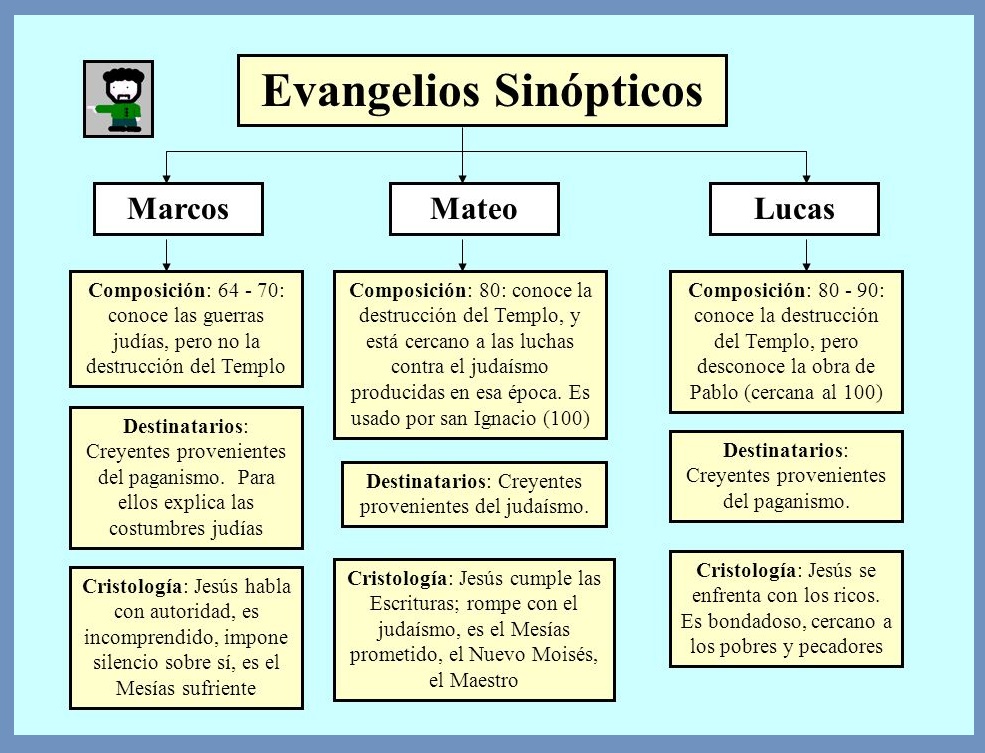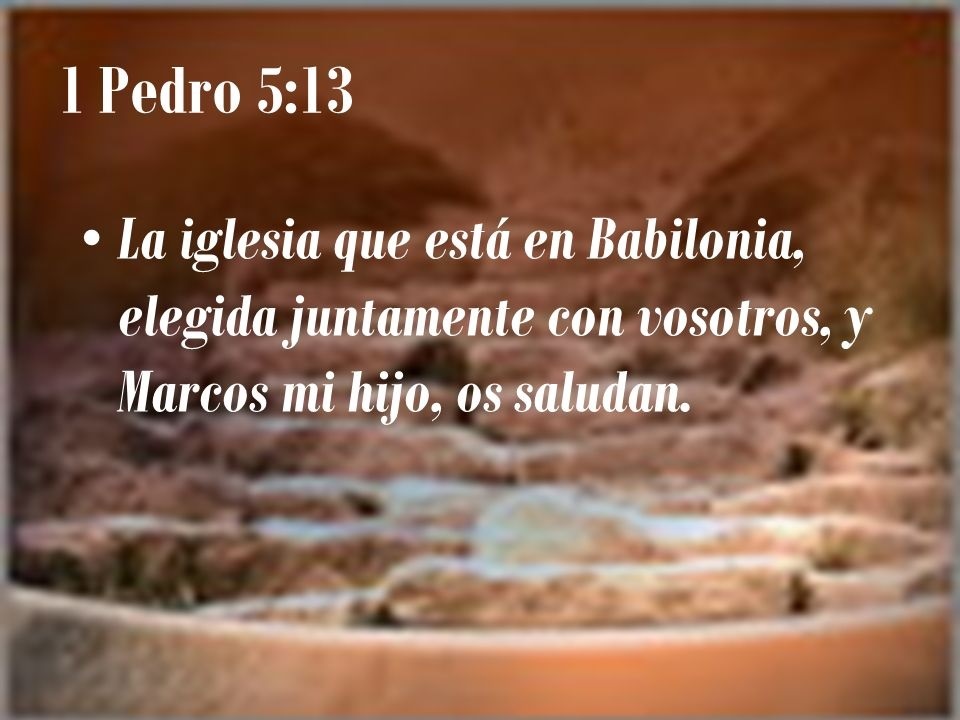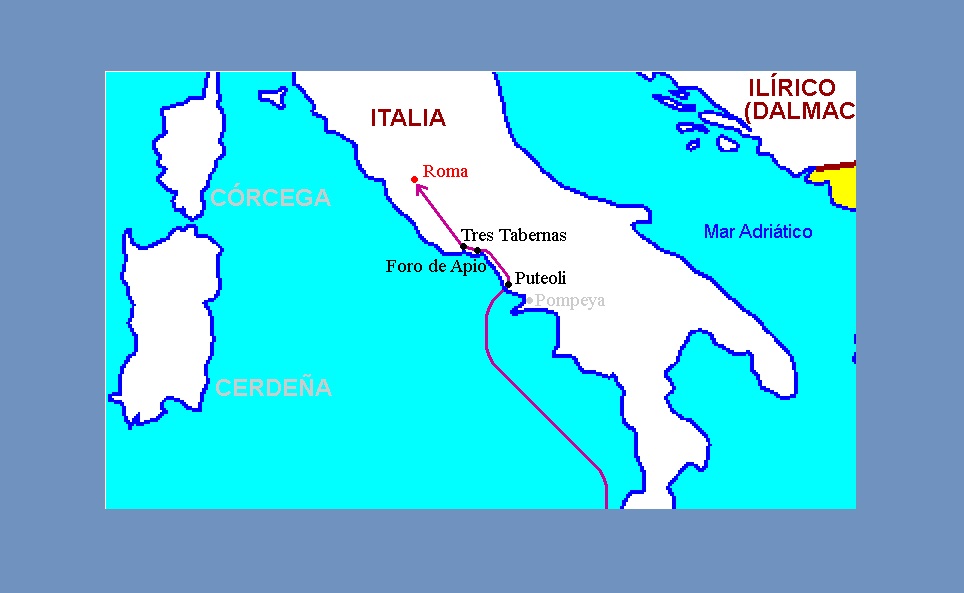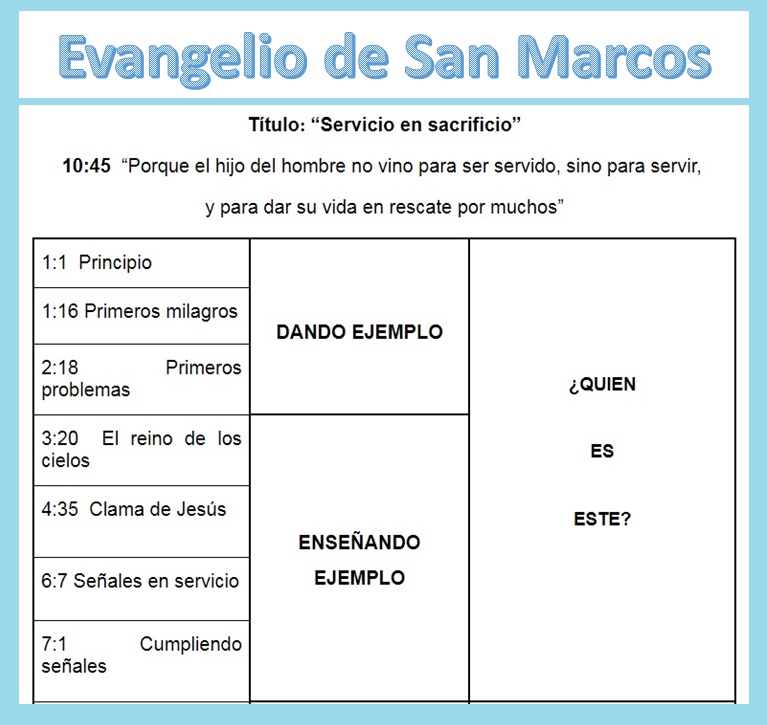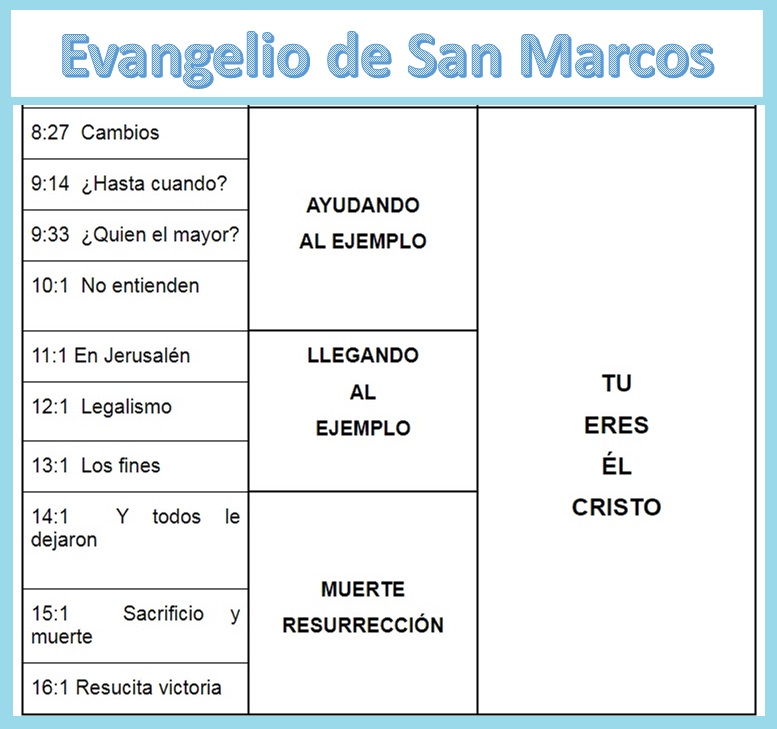Gospel of San Marcos: it is the shortest and the second of the four gospels of the new testament of the Bible. It was the first to be written, approximately in the year 70 of the Christian era, its writing is attributed to a disciple of the Apostle Peter named Juan Marcos.

Gospel of Saint Mark
This gospel recounts in detail the mystery, passion, death and resurrection of our Lord Jesus Christ. Mark narrates the mission of Jesus the messiah announced by the Jewish prophets, emphasizing the service and fulfillment of the atonement by the Savior.
The Gospel of Saint Mark is the good news fulfilled, written according to the interpretation of Mark. Interpreter or follower of the apostle Peter, disciple and follower in turn of Christ. Jesus Christ after his resurrection left the mission to every Christian to go and make disciples in his name, taking the gospel to any corner of the world.
The Gospel is Good News
Gospel a word that comes from the Greek roots eu and angélion – angelia that mean Good News. This is how the term εὐαγγέλιον or euangélion, or rather its corresponding verb euangelizo, has the meaning of: announcing good news. And this is what Mark did when writing this text that is part of the books of the new testament of the Bible. Which was written by men but inspired by God, as testimony and knowledge of the good news that is Jesus Christ.
Returning to the Gospel of Saint Mark, this was done by a converted Christian helper of Peter, an apostle and disciple of Jesus Christ, named John Mark. Which interpreted what he learned from his mentor and with the inspiration of God given through his Holy Spirit, and put it all in writing. Of the four gospels that make up the New Testament, Mark's was the first to be written, it is believed that it was between the 60s and 70s after the first coming of Jesus. This gospel is also the shortest with a total of 16 chapters.
Mark, when writing his gospel, thought more than anything else of non-Jewish pagan people, that is, the Gentiles, as they are called in the Bible. With the objective of reading it they could know the Jewish traditions, and mainly know the mystery, the miracles, the service and the expiatory mission of our Lord Jesus Christ on the cross. And when he met him, he converted to Christianity, thus fulfilling the mission of announcing the gospel of Jesus.
Mark's writing style in his gospel is simple, using simple, lively, spontaneous and rudimentary language, so that it could reach the popular masses of those times. Spreading through the years to the present day. We invite you to enter the following link to inquire about Biblical Theology
Why should the Good News or Gospel of Saint Mark be read?
Reading the Gospel of Saint Mark is to quickly enter the story of how the portentous events and tremendous service of our Savior Jesus Christ unfolded during his stay on earth. Being the most important of these facts the Atonement carried out by Jesus on the Cross for each one of us. A vicissitude that was essential to carry out for the fulfillment of the mission of Jesus as the messiah announced by the prophets.
When you study the Bible in the book of Mark you can see and feel in the Spirit how Jesus fulfilled the will of his heavenly Father. Carrying all sin to the cross, He who became sin without having committed a single one. Through the letters of the Gospel of Saint Mark, the conversion of the readers is very probable. Which find a true meaning to believe and follow Jesus Christ. Recognizing him as the only and sufficient Savior of him.
The Synoptic Aspect of the Gospel of Saint Mark
The Gospel of Saint Mark is one of the three so-called synoptic gospels. Term that relates to the Gospels of Mark, Matthew and Luke, due to the similarity that exists between them in terms of the chronological order of the events reported and their content. The word synopsis comes from two Greek words συν-οψις or syn-opsis, which mean together-see. Indicating with this term the recommendation that the three gospels can be seen at the same time or together.
The first author to grant the synoptic characteristic to the three Gospels of Mark, Matthew and Luke. He was the German text critic Johann Jakob Griesbach, in his analysis of the New Testament gospels of the Bible. This German philologist arranged a novel way of presenting the three gospels, in vertical columns. Which could be seen in parallel and simultaneously or together. Such a presentation was carried out in 1776 in his book entitled Synopsis.
This form of presentation of Griesbach, allowed to determine the close relationship that exists between the Gospels of Mark, Matthew and Luke. To know about the 662 verses found in the Gospel of Saint Mark:
- 406 verses are similar to the Gospels of Matthew and Luke
- 145 verses are similar only to the Gospel of Matthew
- 60 verses are similar only to the Gospel of Luke
- Only 51 of Mark's verses bear no relation to the other two gospels. That is, they do not have a similar in parallel.
According to the Christian culture of the time, it was assumed that the Gospel of Saint Mark was the abridged form of the Gospels of Matthew and Luke. Also affirming that the oldest of them was that of Mateo. This gave rise to the study of the sources of the gospels.
The Sources of the Gospel
Following the synoptic relationship established by the critic Johann Jakob Griesbach, he led many other critics to study the sources of the gospels. One of them was the German Protestant theologian Christian Hermann Weisse (1801-1866), belonging to the old search for the historical Jesus. Weisse and fellow German theologian Christian Gottlob Wilke (1786 – 1854), deduce from their independent studies in 1838, that the Gospel of Saint Mark was an inspiring source for Matthew and Luke to write their gospels.
Theological conclusion that overthrew the beliefs of Christian traditions, that the Gospel of Mark was a summary of Matthew and Luke. Christian Hermann Weisse also states that in addition to Mark's text there was another common source for the Gospels of Matthew and Luke. Later, the Protestant theologian Johannes Weiß (1863-1914), in 1890 named this other common source as Document Q. Denouncing it by the German word Quelle, which translates into source, in the Spanish language. Emerging with this, the theory of the two sources:
- The Gospel of Saint Mark
- The other source or document Q
Sources that according to Johannes Weiß made possible the coincident writings between the three synoptic gospels. That they also believe, was an oral or written custom that was valid for the writing of the three evangelical texts. Below is a brief outline of how the chronology of events was established.
- The life, messages and work of Jesus of Nazareth
- Preaching of the apostles of Christ
- Oral tradition of Christian communities
- Compilations of messages and facts of Jesus
- Two-source hypothesis
- Marcos exclusive documents
- Source or document Q
- In parallel the Gospels of Matthew and Luke. Which used the two previous sources for their writing, in addition to exclusive material from each author, Matthew and Luke.
The Q Fountain
The parallel vision of the three gospels was decisive in observing the convergences between them. However, there are also great divergences between the synoptic gospels. The similarities between the last two writings serve to affirm that both were based on the same source, the Gospel of Saint Mark. While the differences help to determine that each of the gospels has its share of independence or authorship.
Therefore, both the similarities and differences between the three gospels: Mark, Matthew and Luke, give rise to the analysis of the relationship between them. Many studies and hypotheses emerged, but the most accepted as mentioned above was the two-source theory.
Of the two sources, the source Q is so far unknown. It is said that they were a compilation of messages or short speeches of Jesus of Nazareth. But, if you take for granted the fact that none of the three evangelists knew or walked with Jesus. That in addition the writings of him are not born of some literary appetite. All this is enough to assign the evangelists a humble or modest role in their work as writers.
On the other hand, at the time they wrote their texts, Christian traditions were deeply rooted or assumed. What assigns a greater weight to the knowledge of the traditions than to the work of writers of the three evangelists. In addition, very little is known about the process for the formation of the tradition, because its beginnings were oral. Which were transmitted by messages from generation to generation.
But we must also not forget that these texts were written by men but inspired by God. So for the Christian, there is no doubt that the similarities of these three gospels are due solely and exclusively to the guidance of the Spirit of God and not to an imaginary Q source.
Authorship Attributed to Marcos
Over the years, the true authorship of the Gospel of Saint Mark has been analyzed. Since the ancient writings of the gospels do not identify the author, as if the author of the different epistles found in the sacred writings can be identified. The history of these analyzes indicates the authorship of Mark from the last years of the second century of the Christian era.
But what were the reasons for designating Mark as the author of this gospel? Who was actually the scribe or instrument that God used to write this gospel, guided by the Holy Spirit? Early Christian writers said that Mark, Peter's apprentice, had left in writing the memoirs of the apostle Peter, a disciple of Christ.
One of these authors was Eusebius of Caesarea (XNUMXth century), who cites another early author Papias of Hierapolis (XNUMXnd century) and he recalls evidence of John the Presbyter, apostle and disciple of Jesus. On the other hand, there is also the Christian tradition, to attribute the authorship to Mark. A character mentioned several times in verses of the letters of Peter and Paul, as a follower of Peter.
Textual clues to authorship
Among the textual clues that glimpse the possible authorship of Mark on the first and shortest written gospel. The following literary authors can be mentioned:
Eusebius of Caesarea (263 – 339 AD)
Eusebius Pamphilus was a Bishop of Caesarea, also known as the father of Church history. Because he is the author of the earliest writings in the history of Christianity. This character of the first centuries of the Christian era, he wrote a text in the year 339 called Ecclesiastical History. In this work he makes a quote from a text that was lost over time, written by Papías Hierapolis, a Christian figure of the second century.
Papias Hierapolis is believed to have been born between 50 and 60 AD, he died a little after the first half of the XNUMXnd century. He was bishop of Hierapolis in Phrygia, as well as being a follower of John the apostle and a disciple of Christ. The quote that Eusebius makes of Papías's text is about what the old man said according to the following:
- -Mark, who was the apostle Peter's scribe, faithfully wrote down the memoirs of this disciple of Jesus. But not in the same order as the Lord did or said. Since he was not a direct witness of the Lord. But as I said before, he was a follower of Peter. And he adapted his preaching according to the situations in which his listeners found themselves. Thus, the writing of Mark was not a continuous narration of the words and deeds of the Lord. On the other hand, Mark was absolutely faithful in writing down everything that he kept in memory of him. Because he put all his intention in not letting pass anything that he heard from Pedro, not to write any lie or falsehood-
Irenaeus of Lyons (130 – 202 AD)
Irenaeus of Lyon was born in Smyrna, now Turkey, and from the year 189 he was bishop of the city of Lyon. But, in addition, Irenaeus was considered the best of the disciples of Polycarp, Bishop of Smyrna. Who in turn was a follower of the Apostle John, a disciple of Christ.
Irenaeus of Lyons was a staunch enemy of the false doctrine of Gnosticism that arose in the second century. What made him write in the year 180, his main literary work called Against Heresies or Adversus Haereses, name in Latin. In this text Irenaeus writes the following, verbatim:
- -After the death and departure with the Lord of the brothers Pablo and Pedro. Mark, follower of Peter, wrote down all the teachings collected or heard from Peter-
Justin Martyr (Around 100 – 162 or 168 AD)
This character was one of the early Christian apologists. He was born in AD 100 in the Old Testament city of Shechem, present-day Nablus in the West Bank. He raised and educated within a Greek and pagan family. He studied philosophy but after his conversion he dedicated his whole life to spreading what he believed was the true philosophy, the Christian doctrine.
This Christian apologist in his writings makes reference to the fact that the Gospel of Mark represents the first written memories of Peter. He specifically mentions the biblical quote in the book of Acts of the apostles, chapter 10, verses 34 to 40. Saying that in this Peter's speech, the entire content of Mark's gospel is summarized.
The Doubts of Current Critics
As for the authors today, there are some who question the authorship of the gospel in Mark, Peter's apprentice. Since they find what is written in the gospel more in tune with the memories of Paul, or Saul of Tarsus, than with those of Peter. Another reason that makes them doubt is the author's errors in terms of knowledge of the geography of the time.
Errors that could not, according to these authors, come from dictations or preaching from the mouth of Peter. An example of this is manifest in the Gospel of Saint Mark 7:31. Referring to a journey of Jesus from the region of Tire to the Sea of Galilee, passing through Sidon. This crossing is out of all geographical sense, because the region of Sidon is not between the two destinations.
Expressions and Turns of Semitic Languages
Many words or terminologies in Semitic languages such as Aramaic and Hebrew can be found in the New Testament book of Mark. What could indicate that the author was based on a source with domain of these languages. Below are several verses from the gospel, which manifest this theory:
- I like, verb form in stative perfect extracted from the Hebrew in the text of Mark 1:11
- They thought in their hearts, a very common Jewish expression of the old testament that can be read in Mark 2:6
- Save life, translation of a characteristic Hebrew expression, in Mark 3:4
- In the text of Mark 3:17, the author refers to the Boanerges brothers from the Aramaic root bêne regesh, which means sons of thunder.
- The author in Mark 4:12 refers to writings of the old testament corresponding to the Bible in Aramaic. Which are found in Isaiah 6:9-10
- In Mark 5:41 you can read the Aramaic word Talita cumi, which translates into girl
- From the original text of Mark 6:38 the Hebrew expression כמה לחם להם is extracted, which translates as How many loaves do you have for them
- In Mark 7:11 there is a typical Hebrew word Qorban which means offering. Even this whole verse seems to refer to the Jewish book of the Talmud
- The Semitic word efata can be read in Mark 7:34, which the author gives a twist to in the Greek version as make yourself open or open.
- In Mark 14:36, the author uses the Aramaic word abbá whose meaning is an intimate and affectionate adjective of dad, such as daddy or daddy
The author of the gospel also makes some turns using expressions from the Greek version of the Bible and not from the Semitic languages. As could be expected from someone from Judea or with a Jewish tradition. Of these turns the following verse may be mentioned:
- Mark 7:6, where Jesus challenges the Pharisees. Here the evangelist is faithful to the Greek version of the Bible by quoting Isaiah 29:13. He cites that it is profoundly different from the original Hebrew version.
Greek Bible Quotes – New Testament
Christian culture has traditionally linked the evangelist Mark as the author. This Mark for Christian culture is the John Mark of various quotes or biblical verses from the New Testament. Some examples of these verses from the Greek Bible in the New Testament are:
- Pedro 1 5: 13 "The brothers in Christ of the people of God in Babylon, equally chosen as you greet them, as well as Mark my son." In this verse of the epistle of Peter, the apostle reveals his great appreciation for John Mark, who even considers him his son.
- Acts 12: 11 – 12 “Peter after reflecting on what happened, getting rid of the hands of Herod, by the grace of God. He goes and arrives at the home of María, mother of Juan Marcos, where many Christians were gathered in prayer.
- Col. 4: 10 “My fellow prisoner Aristarco sends his regards, as does Marcos, who is Bernabé's cousin. From Marcos, you have already received recommendations from me to receive him well, if he comes to visit you”
- Acts 15: 36 – 38 “Paul tells Barnabas, let's go back to greet our brothers in Christ, that we have in all the cities where we have preached the gospel of the Lord. To find out how they are. Bernabé responds to Pablo, telling him to take Juan Marcos with them. But Paul refuses, because John Mark had left them alone in Pamphylia doing the work that the Lord had entrusted to them.
The Date and Place of Writing of the Gospel of Saint Mark
For the chronological location of the text of the Gospel of Saint Mark, verse 2 of chapter 13 is very relevant. Where the Lord Jesus makes one of his disciples see the majestic building of the temple of Jerusalem; prophesying at the same time the total destruction of this.
The date could then be after the burning of Rome by order of Herod in the year 64 after Christ. And before the fall of Jerusalem into the hands of the Roman troops in the year 70 after Christ.
These dates may be true considering that the evangelist was able to experience and see the destruction of the temple. But it cannot be ruled out that the gospel was written before the destruction of the temple occurred; and that the evangelist wrote it guided by the spirit. If so, it could be said that the gospel was written at the end of the 60st century's XNUMXs. There are many biblical critics today who share this last date of origin of the Gospel of Saint Mark.
As for the place where it was written, the most accepted indications are that it was written in the city of Rome or, failing that, in a region with great influence on the Latin language. Since the gospel text contains many linguistic expressions of Latin. This also places John Mark as the possible evangelist.
Know here the meaning of the seven gifts of the Holy Spirit. These gifts of the Holy Spirit represent a promise of God that was fulfilled at Pentecost. All of them are of great importance for the believer of the word of God, and of the gospel of the Lord Jesus. Already through these gifts you can live a better life and the discernment of knowing which path to take. The Holy Spirit guides the believer through these gifts to fulfill the will of God in them.
For whom the Gospel of Saint Mark was written
The peculiar form of writing that the evangelist used in this text. Without much emphasis on knowledge of Jewish traditions; and if more allusive to Roman culture or customs. They confirm the theory that the evangelist intended this text for the converts in Rome.
This theory reaches greater force, if it is located in the context of what was happening or was happening in those times. The authority and domain was under the power of the Roman Empire. The Romans, faced with the increasing multiplication of the Christian people, had initiated a persecution against them. In this sense, the evangelist wanted to give encouragement, hope and faith to this people of converted believers who suffered from persecution.
Content of the Gospel of Saint Mark
The main objective of the evangelist to write this text of the new testament, was to discover in the person of Jesus the son of God, as well as his works and teachings. So the content of this gospel is the life, death and resurrection of Jesus. Mark shows us Jesus as an obedient servant of Jehovah God, his father. And he does this by describing in detail the suffering, sacrifice and death of Jesus for the salvation of all. Sacrifice that he made without respect of persons, loving everyone equally.
This fast-paced, short gospel contains the writings of a boy who stood by the humble fisherman; that he witnessed the life of Jesus on earth, the apostle Peter. This young man manages to portray a true and living Jesus, emphasizing his works, writing what is fair and necessary. The service of Jesus is the center of this text: "Since the son of man did not come to be served, but to serve and give his life for the salvation of many", Mark 10:45
The gospel contains the narrative of the life of Jesus from the announcement of John the Baptist, and the baptism in his hands. Then it shows Jesus working on the works of his father in heaven, working miracles, healing the sick, helping the needy, preaching to the people, setting captives free, and bringing light where darkness or darkness existed. Then he ends his account full of details, of the suffering, of the sacrifice of Jesus on the cross for the atonement of many and his resurrection to go to the reunion with his Father in heaven.
All this content of accounts of the life of Jesus on earth written by Mark. It served to strengthen the Roman believers of the time who suffered persecution. And they still serve to strengthen all believers in the world, whether or not they suffer from persecution. Because it teaches the Christian people to live confidently, without any fear, even without fear of death. And he invites us to follow Jesus as an example of life, with all the implications that this may have. He further calls believers to a ministry of service.
In spiritual battles, the armor of God is essential for obtaining victory against the enemy, God trains his children, fills them with words and blessings, never departs, is there at all times, among them is presented that provides the use of their armor that allows them to be more than conquerors. For this we invite you to read Ephesians 6: Armor of God, powerful in any battle.
exorcisms and cures
Of the works of Jesus related in the Gospel of Saint Mark, four stories of exorcisms performed by the messiah can be found. Read the following biblical quotes:
- 1.- Mark 1: 21 – 28
- 2.- Mark 5: 1 – 20
- 3.- Mark 7: 24 – 30
- 4.- Mark 9: 14 – 29
You can also find eight stories narrated in detail, about healings that Jesus performed on several sick people. Read the following biblical quotes:
- 1.- Mark 1: 29 – 31
- 2.- Mark 1: 40 – 45
- 3.- Mark 2: 1 – 12
- 4.- Mark 3: 1 – 6
- 5.- Mark 5: 25 – 34
- 6.- Mark 7: 31 – 37
- 7.- Mark 8: 22 – 26
- 8.- Mark 10: 46 – 52
The end of the Gospel of Mark
About the end of the Gospel of Saint Mark, specifically from chapter 16, verse 9. The authors or critics of the biblical texts refer to these last stories as added later. These stories are about:
- Apparition of the Lord Jesus to Mary Magdalene
- The Lord Jesus appears to two of his disciples
- Jesus the Lord commissions the apostles
- The ascension of the Lord
This statement that verses 9 to 20 of the last chapter of the Gospel of Saint Mark were added. This is because they are not found in ancient manuscripts. In addition, the tone and style of narration is different from the rest of the text. To finish this article it can be said that the teachings of the apostle Peter, learned from the Master Jesus the Son of God. They were like a light that shone in the minds and hearts of all those to whom he preached, who were not satisfied with just keeping the message of the gospel of Jesus in his memories.
So surely they insisted that Peter leave them in writing the teaching they had received. And this term entrusting his disciple John Mark to write his memoirs on the gospel of Jesus. It is also said of this that Peter had a revelation from the Holy Spirit to carry out this assignment in the hands of Mark as scribe. Later establishing this text for the use of the church of Jesus on earth.
And it is that, The same God who said: "The light will shine in the darkness", filled our hearts with light so that we could have knowledge of his glory through the light that shines on the face of Jesus Christ- Amen. (2 Corinthians 4:6). God allow this word to become rhema in your life.
We invite you to continue knowing the word of God, reading The Gospel of Matthew. This is the first book of the New Testament of the Bible, which contains the stories of how Jesus performed his miracles, his sermons and his teachings before his crucifixion, in 28 chapters. Its purpose is focused on conveying the message that the Messiah that was announced in the Old Testament is Jesus, it is also one of the three so-called synoptic gospels.

